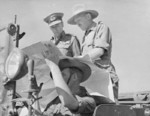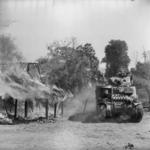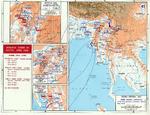Battle of Meiktila-Mandalay
Contributor: C. Peter Chen
ww2dbaseIn Nov and Dec 1944, William Slim's British 14th Army secured two bridgeheads across the Chindwin River in Burma. Slim imagined that the Japanese would expect the Anglo-Indian troops to march for the historic city of Mandalay next, thus he devised a plan to attack Meiktila instead. Located 150 kilometers to the south, Meiktila represented a main stop on the supply route for food and ammunition for Japanese troops in central and northern Burma, thus by capturing Meiktila, Slim believed that he would be able to isolate the entire northern Burma with ease for a quick victory. To hide the fact that he wished to capture Meiktila before Mandalay, a number of deceptions were planned, including the transfer of several units from the Indian 4th Corps (the unit charged to take Meiktila) to the Indian 33rd Corps to make the Japanese think that the 4th Corps was not on the move further to the south, the use of irregular troops in front of the 4th Corps because the British had usually only used irregulars in Japanese rear areas rather than main battlegrounds prior to this time, and the establishment of a fake 4th Corps headquarters complete with a signals staff to transmit dummy radio traffic. By mid-Jan 1945, Anglo-Indian troops had reached the region where the Chindwin River joined the Irrawady River. As the Indian 33rd Corps feinted toward Mandalay, the Indian 4th Corps began its secret march in the Gangaw Valley along the Myittha River toward Meiktila on 19 Jan with Indian 7th Division at the spearhead. The Japanese mounted counterattacks almost nightly against the entire Allied front, not realizing Meiktila was the main objective and not able to make significant advances against any of the Anglo-Indian offensives. On 23 Feb 1945, the British 2nd Division crossed the Irrawady RIver 10 miles west of Mandalay. Allied air superiority during this phase of the campaign in Burma played a decisive role, knocking out field guns and the few remaining Japanese tanks. The few Japanese aircraft remaining in the region could offer only little resistance.
ww2dbaseOn 29 Feb 1945, the attack on the Meiktila region began by the troops of Major General David Cowan's Indian 17th Division, quickly taking the airfield 20 miles west at Thabutkon. The Indian 99th Brigade and fuel supplies were called in by air immediately. Meiktila was defended for the most part by men of the 168th Regiment of the Japanese 49th Division, with additional manpower from various support units such as communications personnel; the Japanese totaled about 4,000. On 1 Mar, Meiktila itself came under attack, and Cowan soon realized that the Japanese were well-entrenched in the city; snipers, mutually-reinforcing bunkers, machine gun nests, and anti-tank gun positions were practically everywhere. After hard fighting, Anglo-Indian troops captured the city by 3 Mar, and by 5 Mar all Japanese resistance in the region were eliminated. The Allies captured 47 Japanese prisoners; a majority of the remainder were killed or committed suicide.
ww2dbaseThe Japanese were not ready to give up on Meiktila, however. The Japanese 18th and 49th Divisions, along with composite units, mounted an attack at a strength of 12,000 men. The 15,000-strong Indian 17th Division first attempted to attack out of the newly occupied town to clear out Japanese concentrations, but soon was pressured to fall back. The first attack on Meiktila by the Japanese failed with heavy losses, however. Lieutenant General Eitaro Naka changed his strategy on 13 Mar by attacking the airfields nearby to deprive the defending forces of their supplies. By 15 Mar, aircraft landing had to done so under fire. Cowan called off the supply runs on 18 Mar. Toward the end of Mar 1945, with the attacking Japanese units not in good communications with each other, the siege of Meiktila gradually fell apart.
ww2dbaseElsewhere, British and Indian troops reached Mandalay Hill on 7 Mar 1945. With Meiktila already captured by the Allies, Mandalay would wither without adequate supplies, but Slim wanted a victory at this historically important city. Major General Seiei Yamamoto, the defending general at Mandalay, was as determined to hold the city for its propaganda value as much as Slim wanted to take it. On 8 Mar, 4/4th Gurkha Rifles of Indian 19th Division began to advance on Mandalay Hill, which was not bombarded due to the presence of many templates and pagodas. Fighting from subterranean tunnels, the Japanese held on for several days before falling back. The city itself was next. At Fort Dufferin, the thick walls held up against Allied artillery shelling and aerial bombardment, and the deep moat thwarted the attacking infantry. As the casualty numbers mounted, British generals drew up a commando raid through the sewers to penetrate the fortress defenses, but the plan would not be executed as the Japanese unexpectedly surrendered Fort Dufferin, thus Mandalay, on 20 Mar.
ww2dbaseThe defeat of the Japanese forces at Meiktila and Mandalay was decisive, with the Japanese suffering heavy casualties and losing valuable heavy equipment necessary to carry on the war. Politically, the defeat also dealt the Japanese great damage. The fall of Mandalay, a cultural center of Burma, turned Burmese national opinion against the Japanese, while losing the river and road network north of Meiktila meant that the Japanese forces in northern Burma were now effectively cut off from the sources of supply generally flowing in from the Rangoon area. The number of attacks by Burmese guerilla on Japanese troops surged after the Battle of Meiktila-Mandalay. Shortly, even the Burmese regulars of the Japanese-sponsored puppet republic would turn their guns on the Japanese.
ww2dbaseSources:
Frank McLynn, The Burma Campaign
Wikipedia
Last Major Update: Oct 2006
Photographs
 |  |  |  |
Maps
 |  |  |
Battle of Meiktila-Mandalay Timeline
| 28 Nov 1944 | Anglo-Indian troops captured Kalewa, Burma. |
| 3 Dec 1944 | Indian 20th Division crossed the Chindwin River into Burma. |
| 10 Dec 1944 | The world's longest Bailey bridge (at the length of 1,154 feet) was completed over the Chindwin River in Burma by the Anglo-Indian troops. |
| 18 Dec 1944 | William Slim met with Montagu Stopford of Indian 33rd Corps and Frank Messervy of Indian 4th Corps regarding Operation Extended Capital which aimed at the total defeat of Japanese forces in Burma. |
| 19 Dec 1944 | William Slim completed a two-day meeting with Montagu Stopford and Frank Messervy regarding Operation Extended Capital. Meanwhile, in the field, Indian 2nd Division relieved Indian 20th Division and began marching for Shwebo, Burma 40 miles northwest of Mandalay. Finally, Indian 19th Division captured Wuntho en route to Pinlebu and Pinbon, Burma. |
| 23 Dec 1944 | Indian 2nd and 20th Divisions reached Pyingaing, Burma, which was not defended by the Japanese. |
| 26 Dec 1944 | William Slim transferred 19th Division and 268th Armored Brigade from the Indian 4th Corps to the Indian 33rd Corps to hide from Japanese intelligence the fact that the 4th Corps was about to secretly move through the Gangaw Valley along the Myittha River for Meiktila, Burma. A fake 4th Corps headquarters was also to be set up at Tamu. |
| 2 Jan 1945 | Indian 2nd Division reached Yeu and crossed the Mu River in Burma. |
| 7 Jan 1945 | Anglo-Indian troops reached the outskirts of Shwebo, Burma. |
| 9 Jan 1945 | Indian 19th Division captured Shwebo, Burma. |
| 14 Jan 1945 | After sundown, Indian 19th Division crossed the Irrawady River near Kyaukmyaung, Burma, 20 miles south of Thabeikkyin and 40 miles north of Mandalay. |
| 17 Jan 1945 | Japanese forces in Burma began organizing counterattacks against the latest Anglo-Indian offensive. |
| 18 Jan 1945 | Allied aircraft attacked Japanese positions at Monywa, Burma while the Indian 20th Division assaulted the port city on the Chindwin River. |
| 19 Jan 1945 | Allied aircraft attacked Japanese positions at Monywa, Burma while the Indian 20th Division assaulted the port city on the Chindwin River. Meanwhile, Indian 4th Corps began its secret march southward for Meiktila, Burma. |
| 20 Jan 1945 | Allied aircraft attacked Japanese positions at Monywa, Burma while the Indian 20th Division assaulted the port city on the Chindwin River. Meanwhile, Japanese forces in Burma began a coordinated counteroffensive against the latest Anglo-Indian advances. |
| 22 Jan 1945 | Indian 20th Division captured Monywa, Burma on the Chindwin River and reached the Irrawady River at Myinmu. |
| 23 Jan 1945 | Anglo-Indian troops captured Myinmu, Burma. The last Japanese survivors drowned themselves in the Irrawaddy River to avoid capture. |
| 25 Jan 1945 | Anglo-Indian and Japanese troops clashed at Kabwet, Burma. |
| 28 Jan 1945 | Anglo-Indian troops captured Pauk, Burma. |
| 3 Feb 1945 | Frank Messervy ordered his Indian 4th Corps to attack Chauk and Pagan, Burma. |
| 8 Feb 1945 | The 28th East African Brigade attacked Seikpyu, Burma as a feint. |
| 10 Feb 1945 | Indian 114th Brigade captured Pakkoku 20 kilometers southwest of the Chindwin-Irrawaddy confluence in Burma. |
| 12 Feb 1945 | Indian 20th Division crossed the Irrawady River at Myinmu, Burma. |
| 13 Feb 1945 | Indian 7th Division crossed the Irrawady River at Nyaungu, Burma. |
| 16 Feb 1945 | Indian 17th Division began crossing the Irrawady River in Burma. |
| 17 Feb 1945 | Indian 17th Division completed its crossing of the Irrawady River in Burma. Meanwhile, the Japanese counterattack on the Indian 7th Division at Nyaungu, Burma was turned by the Anglo-Indian troops, and the Japanese troops began falling back into the town. |
| 24 Feb 1945 | Indian 2nd Division crossed the Irrawady River at Ngazumi, Burma and met heavy Japanese resistance. |
| 26 Feb 1945 | Indian 2nd Division completed the crossing of the Irrawady River at Ngazumi, Burma. |
| 1 Mar 1945 | British tanks spearheaded the first assault on Meiktila. |
| 2 Mar 1945 | Anglo-Indian troops attacked Meiktila, Burma. |
| 3 Mar 1945 | Anglo-Indian troops captured Meiktila, Burma after the final 47 Japanese defenders committed suicide. Japanese resistance in outskirts of the city would continue for a few more days. |
| 5 Mar 1945 | All Japanese pockets of resistance at Meiktila, Burma were eliminated. |
| 7 Mar 1945 | Anglo-Indian troops reached Mandalay, Burma. |
| 8 Mar 1945 | Indian 19th Division began attacking Mandalay Hill near Mandalay, Burma. |
| 10 Mar 1945 | Anglo-Indian troops continued to assault Mandalay Hill near Mandalay, Burma. |
| 11 Mar 1945 | Anglo-Indian troops continued to assault Mandalay Hill near Mandalay, Burma. |
| 12 Mar 1945 | Japanese troops launched a counteroffensive aimed at recapturing Meiktila, Burma. |
| 15 Mar 1945 | Anglo-Indian troops surrounded Fort Dufferin in Mandalay, Burma. |
| 16 Mar 1945 | Anglo-Indian troops assaulted Fort Dufferin in Mandalay, Burma in failure, suffering heavy casualties. |
| 17 Mar 1945 | The Indian 5th Division arrived in the Meiktila, Burma area. To the south, Anglo-Indian troops again assaulted Fort Dufferin in Mandalay, Burma in failure, suffering heavy casualties. |
| 18 Mar 1945 | Indian 5th Division captured Myingyan, Burma. In the area, Anglo-Indian troops attempted to cross the moat of Fort Dufferin in Mandalay, Burma in failure, suffering heavy casualties. |
| 19 Mar 1945 | Anglo-Indian troops attempted to cross the moat of Fort Dufferin in Mandalay, Burma in failure, suffering heavy casualties. A commando raid was put together to penetrate the fortress, but it would not be carried out due to the unexpected Japanese surrender on the next day. |
| 20 Mar 1945 | Indian 19th Infantry Division captured Mandalay, Burma. |
| 22 Mar 1945 | Anglo-Indian troops eliminated all Japanese pockets of resistance in the Myingyan region in Burma. |
| 29 Mar 1945 | The Japanese called off the attempt to recapture Meiktila, Burma. |
| 30 Mar 1945 | Indian 19th Division captured Kyaukse, 20 miles south of Mandalay, Burma. |
| 7 Apr 1945 | Anglo-Indian troops attacked Yindaw, which was 20 kilometers south of Meiktila, Burma. It was stubbornly defended by 1,000 Japanese troops which repeatedly repulsed assaults over the next few days. William Slim would ultimately order the town bypassed, leaving it for the mop-up phase later. |
| 19 Apr 1945 | British troops wiped out 500 Japanese troops at Mount Popa, Burma west of Meitkila after 20 days of heavy fighting. |
Please consider supporting us on Patreon. Even $1 per month will go a long way! Thank you. Please help us spread the word: Stay updated with WW2DB: |
Visitor Submitted Comments
16 Nov 2014 04:07:56 PM
My father flew the DC3 in with supplies and out with the wounded. He is 92 now, I have his flight log book with all trips recorded
6 Sep 2015 09:14:14 AM
A very good, concise article. Meiktila was a brilliant stroke by Slim. Although McLynn speaks highly of Slim, better sources are Slim's humble "Defeat Into Victory", Louis Allen's verbal snapshots "Burma: The Longest War" and Robert Lyman's "Slim, Master of War".
16 Apr 2020 02:12:08 AM
Why are the RAF Servicing Commando units who fought alongside army units at Meiktila never mentioned. My Dad was at Meiktila but apart from 1 book about the RAF Commando units they might as well not have existed despite taking part in the D-Day landings as well. D-Day+1 in his case. They were not in France for long and were then sent to India and then Burma where they fought at Meiktila. My father had terrible memories of wading through the bodies of many hundreds of ANZAC troops after beach landings near Port Swettenham. He later described helping to repatriate some prisoners from Japanese prison camps in Burma including a number of nuns who had survived the camps. He said he and his comrades cried at the state of the women and their disbelief and then utter relief that they were really going home. He didn’t get home to Scotland until 1947. Years later he discovered one of his friends who he had known for 20 years ( both were head teachers whose schools shared a campus - 1 a secondary school head ,the other primary school head) had been in charge of the artillery battery that tried to help protect my Dad’s unit at Meiktila. Sorry if any inaccuracies, I wish I had written Dad’s memories down or better still made him write them down. He probably wouldn’t have done it. I only heard some of this because of sitting quietly while he talked about it with his friend & colleague.
27 Apr 2020 09:35:22 AM
Anonymous in 2014 posted that his Dad flew in the DC3 that took out the wounded. My Dad had his field hospital at the airfield and was apparently the only surgeon in the area. It was probably his patients that they were carrying out. I visited Meiktila a few years ago, and Bagan where the Irriwaddy river crossing happened. A trip worth taking.
All visitor submitted comments are opinions of those making the submissions and do not reflect views of WW2DB.

» Honda, Masaki
» Slim, William
Location:
» Burma
Related Book:
» The Burma Campaign: Disaster into Triumph 1942-45
- » 1,181 biographies
- » 337 events
- » 45,132 timeline entries
- » 1,249 ships
- » 350 aircraft models
- » 207 vehicle models
- » 376 weapon models
- » 123 historical documents
- » 261 facilities
- » 470 book reviews
- » 28,426 photos
- » 365 maps
Winston Churchill
Please consider supporting us on Patreon. Even $1 a month will go a long way. Thank you!
Or, please support us by purchasing some WW2DB merchandise at TeeSpring, Thank you!
24 Oct 2006 06:21:18 AM
this is pretty interresting